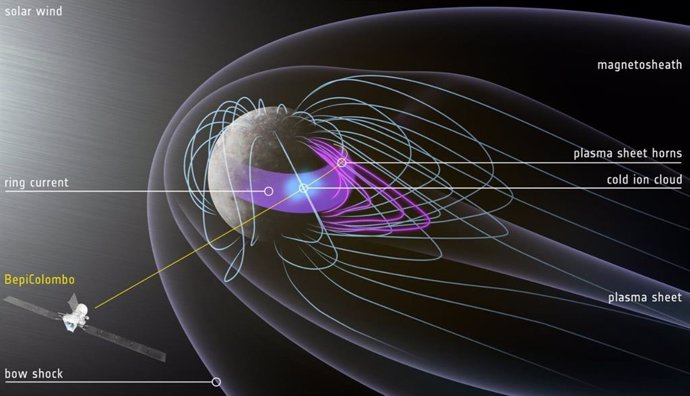Mercury’s magnetosphere during the third BepiColombo flyby. – THAT
Oct. 4 () –
The ESA/JAXA BepiColombo spacecraft has taken advantage a recent gravity flyby of Mercury to obtain a stunning image of the planet’s magnetic landscape in just half an hour.
For this objective, the Mercury Plasma Particle Experiment (MPPE) instrument suite active on the Japanese Mercury Magnetospheric Orbiter (MMO, or Mio) was used, which is one of the two scientific orbiters that will be deployed when the mission finally orbits Mercury in 2026. The results have been published in the journal Communications Physics.
“These flybys are fast; we cross Mercury’s magnetosphere in about 30 minutes, going from dusk to dawn and with a closest approach of only 235 km above the planet’s surface,” he said. in a statement Lina Hadid, a former ESA researcher who now works at the Laboratoire de Physique des Plasmas at the Paris Observatory and who led the study. “We sample the type of particles, their temperature and how they move, “which allowed us to clearly map the magnetic landscape during this brief period.”
Combining BepiColombo measurements with computer models to determine the origin of the detected particles based on their motion allowed Hadid and her colleagues to outline the different features found in the magnetosphere.
“We saw expected structures, such as the ‘shock’ boundary between the free-flowing solar wind and the magnetosphere, and we also passed by the ‘horns’ flanking the plasma layer, a region of hotter, denser electrically charged gas flowing like a tail in the opposite direction to the sun. But we also had some surprises.”
Co-author Dominique Delcourt added: “We detected a so-called low-latitude boundary layer defined by a region of turbulent plasma at the edge of the magnetosphere, and here we observed particles with a much wider range of energies than we had seen before on Mercury. largely thanks to the sensitivity of the Mass Spectrum Analyzer designed especially for the complex environment of Mercury.”
“BepiColombo will be able to determine the ionic composition of Mercury’s magnetosphere in greater detail than ever before. We also observe energetic hot ions near the equatorial plane and at low latitudes trapped in the magnetosphere, and we believe the only way to explain this is by a ring current , whether it is a partial or full ring, but this is an area that is highly debated,” Hadid adds.
An annular current is an electrical current carried by charged particles trapped in the magnetosphere. The Earth has a well-known ring current that is located tens of thousands of kilometers from its surface. On Mercury, it is less clear how particles can become trapped within a few hundred kilometers of the planet, especially when the magnetosphere is crushed against the planet’s surface. This debate will likely be resolved once MPO and Mio are collecting data full time.
Hadid and her colleagues also observed the direct interaction of the spacecraft with the surrounding space plasma. When the spacecraft is heated by the sun, it cannot detect the colder, heavier ions because the spacecraft itself becomes electrically charged and repels them.











![[Img #74674]](https://thelatestnews.world/wp-content/uploads/2024/12/Santiago-Ramon-y-Cajal-The-promoter-of-modern-neuroscience-300x200.jpg)
Add Comment